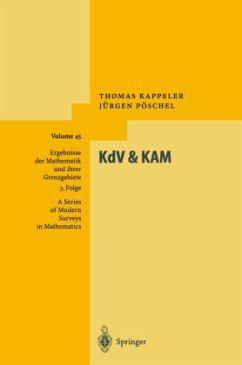In this text the authors consider the Korteweg-de Vries (KdV) equation (ut = - uxxx + 6uux) with periodic boundary conditions. Derived to describe long surface waves in a narrow and shallow channel, this equation in fact models waves in homogeneous, weakly nonlinear and weakly dispersive media in general.
Viewing the KdV equation as an infinite dimensional, and in fact integrable Hamiltonian system, we first construct action-angle coordinates which turn out to be globally defined. They make evident that all solutions of the periodic KdV equation are periodic, quasi-periodic or almost-periodic in time. Also, their construction leads to some new results along the way.
Subsequently, these coordinates allow us to apply a general KAM theorem for a class of integrable Hamiltonian pde's, proving that large families of periodic and quasi-periodic solutions persist under sufficiently small Hamiltonian perturbations.
The pertinent nondegeneracy conditions are verified by calculating the first few Birkhoff normal form terms -- an essentially elementary calculation.
Viewing the KdV equation as an infinite dimensional, and in fact integrable Hamiltonian system, we first construct action-angle coordinates which turn out to be globally defined. They make evident that all solutions of the periodic KdV equation are periodic, quasi-periodic or almost-periodic in time. Also, their construction leads to some new results along the way.
Subsequently, these coordinates allow us to apply a general KAM theorem for a class of integrable Hamiltonian pde's, proving that large families of periodic and quasi-periodic solutions persist under sufficiently small Hamiltonian perturbations.
The pertinent nondegeneracy conditions are verified by calculating the first few Birkhoff normal form terms -- an essentially elementary calculation.
From the reviews:
"The monograph is concerned with a natural question that arises once a partial differential equation ... is understood as an infinite dimensional completely integrable Hamiltonian system. ... The book under review is extremely well written. ... This book should certainly be of interest to anyone working in the areas of finite dimensional Hamiltonian dynamics or completely integrable partial differential equations ... ." (A. Pickering, Zentralblatt MATH, Vol. 1032 (7), 2004)
"The main topic of the present book is the periodic Korteweg de Vries equation ... . It is well written and comes with an introduction to integrable Hamiltonian systems and KAM theory, which makes it self-contained and accessible to graduate students as well. As an additional bonus, all chapters can be read independently of each other. I can only highly recommend it to anybody interested in infinite dimensional integrable systems." (G.Teschl, Internationale Mathematische Nachrichten, Issue 196, 2004)
"In this elegantly written book, the authors approach two essential facets of the Hamiltonian PDEs theory ... . the results stated in the book ... are exposed in a very clear and pedagogical way and they provide a quite complete picture of the two subjects: 'Kdv' and 'KAM'. ... the illuminating overview and the introductions of each chapter make these difficult (and technical) subjects accessible to nonspecialists." (Benoît Grébert, Mathematical Reviews, 2004 g)
"This book deals with the problem of describing the qualitative behaviour of the solutions of the Korteweg de Vries equation (KdV) ... . The book contains full proofs of all the results presented. This is quite a remarkable fact since previously the interested scientist had to look at many different places ... . Furthermore, the proofs presented in the book are original ... . Everything is presented starting from the beginning so that the book turns out to be accessibleto a graduate student." (D. Bambusi, Jahresbericht der Deutschen Mathematiker-Vereinigung, Vol. 108 (3), 2006)
"The monograph is concerned with a natural question that arises once a partial differential equation ... is understood as an infinite dimensional completely integrable Hamiltonian system. ... The book under review is extremely well written. ... This book should certainly be of interest to anyone working in the areas of finite dimensional Hamiltonian dynamics or completely integrable partial differential equations ... ." (A. Pickering, Zentralblatt MATH, Vol. 1032 (7), 2004)
"The main topic of the present book is the periodic Korteweg de Vries equation ... . It is well written and comes with an introduction to integrable Hamiltonian systems and KAM theory, which makes it self-contained and accessible to graduate students as well. As an additional bonus, all chapters can be read independently of each other. I can only highly recommend it to anybody interested in infinite dimensional integrable systems." (G.Teschl, Internationale Mathematische Nachrichten, Issue 196, 2004)
"In this elegantly written book, the authors approach two essential facets of the Hamiltonian PDEs theory ... . the results stated in the book ... are exposed in a very clear and pedagogical way and they provide a quite complete picture of the two subjects: 'Kdv' and 'KAM'. ... the illuminating overview and the introductions of each chapter make these difficult (and technical) subjects accessible to nonspecialists." (Benoît Grébert, Mathematical Reviews, 2004 g)
"This book deals with the problem of describing the qualitative behaviour of the solutions of the Korteweg de Vries equation (KdV) ... . The book contains full proofs of all the results presented. This is quite a remarkable fact since previously the interested scientist had to look at many different places ... . Furthermore, the proofs presented in the book are original ... . Everything is presented starting from the beginning so that the book turns out to be accessibleto a graduate student." (D. Bambusi, Jahresbericht der Deutschen Mathematiker-Vereinigung, Vol. 108 (3), 2006)








